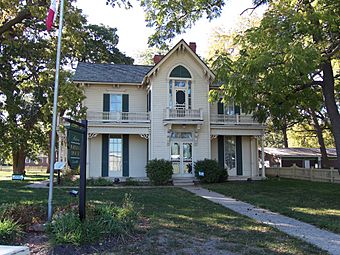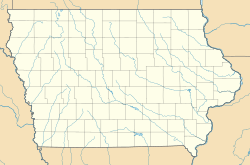Jordan House (West Des Moines, Iowa) facts for kids
Quick facts for kids |
|
|
Jordan House
|
|
 |
|
| Location | 2251 Fuller Rd. West Des Moines, Iowa |
|---|---|
| NRHP reference No. | 73000738 |
| Added to NRHP | December 10, 1973 |
The Jordan House is a very old and important building in West Des Moines, Iowa. It was built by James C. Jordan, who was against slavery. This house was a secret stop on the Underground Railroad in Iowa. It helped many enslaved people find freedom. The Jordan House has been recognized as a special historic place since 1973. Today, it is a museum where you can learn about its amazing past.
Contents
Meet James C. Jordan
James C. Jordan was a cattle farmer from Virginia, which is now part of West Virginia. He moved to central Iowa in 1846. Mr. Jordan was a smart businessman. He helped start the State Bank of Des Moines. He also worked hard to bring the railroad to Des Moines.
He planned out an area called Valley Junction. He even raised a lot of money to build a train station there. This area is now the city of West Des Moines. James Jordan was also a leader in his community. He served on the Polk County Board of Supervisors. He was also elected to both the Iowa Senate and the Iowa House of Representatives. While in the state government, he helped move Iowa's capital from Iowa City to Des Moines.
James Jordan was married twice. He had six children with his first wife, Melinda. After she passed away, he married Cynthia Adams. Together, they had a large family with eleven children.
History of the Jordan House
When James Jordan first arrived in Polk County, he lived in a simple tent. In 1848, he built a log cabin. Just two years later, in 1850, work began on the house you see today. The family moved into the basement first. It had a kitchen and a room for sleeping and living.
In 1851, the main part of the house was finished. It was a beautiful two-story white house. The first part of the house had a fancy entrance. It also had two big rooms on the first floor. A lovely staircase made of walnut wood led to two large bedrooms upstairs. The kitchen stayed in the basement.
A Secret Stop on the Underground Railroad
Before the American Civil War, the Jordan House was a secret station on the Underground Railroad. James Jordan strongly believed that slavery was wrong. He was known as the main "conductor" in Polk County. A famous person named John Brown stayed at the house at least two times. One time, he was helping 12 enslaved people escape to freedom.
The house was also a stopping point for many travelers. They would rest there on their long journeys to the American West. It was also a popular place for local business people and politicians to meet.
The House Grows and Changes
The Jordan House became even bigger in 1870. A new section was added. This new part included another living room, a dining room, a library, and a kitchen. Porches were built on the east and south sides of the house. A second entrance was also added. This new entrance had another black walnut staircase. It led to six more bedrooms on the second floor.
From Home to Museum
The Jordan family lived in the house until 1947. Then, they sold it to the Church of the Nazarene. The church used the house as part of their summer camp. In 1978, the West Des Moines Historical Society bought the house. They carefully fixed it up to look like it did in the past. Now, it is a museum. People can visit to learn about its history and the brave people who lived there.



